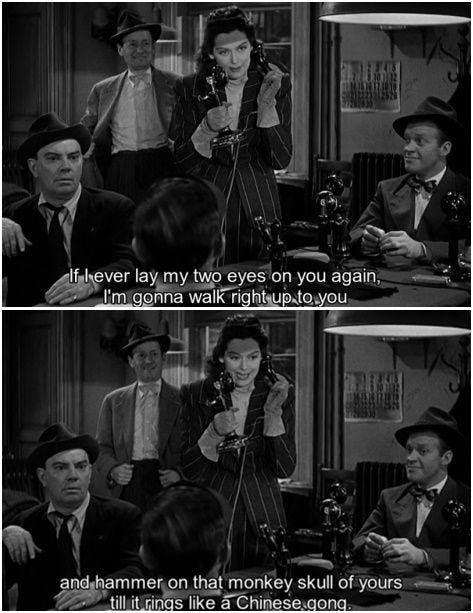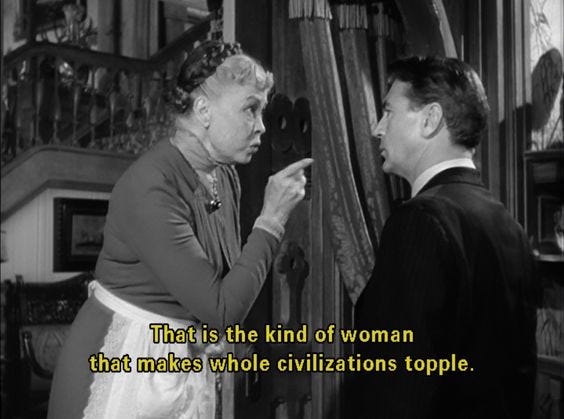Howard Hawks had zero interest in feminism. He just wanted to make good movies — and that happened to require strong, fast-talking leading ladies.
“I’ve been accused of promoting Women’s Lib, and I’ve denied it, emphatically,” the prolific American director said in an interview with Joseph McBride for his book Hawks on Hawks. “It just happens that kind of a woman is attractive to me.”
Hawks (1896-1977) worked in nearly every genre from the Jazz Age to the dawn of disco, famously defining a worthy film as “three great scenes, no bad ones.” From Scarface to His Girl Friday to Gentlemen Prefer Blondes to Rio Bravo to The Thing From Another World, he figured out an easy formula for more interesting screenplays:
“And I’ve seen so many pictures where the hero gets in the moonlight and says silly things to a girl, I’d reverse it and let the girl do the chasing around, you know, and it works out pretty well.”
The result was The Hawksian Woman, a term coined by critic Naomi Wise in 1970 essay in the Montreal film magazine Take One to describe the “consequential roles” in Hawks’ films in which “the good girl and bad girl are fused into a single, heroic heroine, who is both sexual and valuable.”
While the men in these movies were “professionally skilled (as fliers, gunmen, racing drivers, etc.), Hawksian women are professional human beings.”
The director recounted his discussion with screenwriter Jules Furthman that led to these ladies:
“Do you suppose we can make a girl who is insolent, as insolent as Bogart, who insults people, who grins when she does it, and people like it?”
“Where are you going to find such a creature?”
“I don’t know, but we can try writing it.”
These women give better than they get, Wise argues, because they arrive on screen fully formed: “The men tend to suffer emotional blocks that keep them from full self-realization, while the women need merely to adjust to a particular situation.”
And so you have reporter Hildy Johnson (Rosalind Russell) running circles around her ex-husband/ex-boss Walter Burns (Cary Grant) in 1940’s His Girl Friday, telling him “I wouldn’t cover the burning of Rome for you if they were just lighting it up” and:
If she’s the kind of woman that women want to be and men want to be with, she’s Hawksian woman. On film, the archetype sadly went out of style in the 1950s. But can it work in real life, even without a smiling Cary Grant to return serves like a table-tennis savant?
Naomi Wise stops short of a full endorsement, though she does say that the Hawksian woman “can be very helpful as a guide for competent behavior in certain specific situations.”
Happily, Hawks coached his leading ladies to inhabit this persona, an assignment Lauren Bacall easily aced:
“I don’t do too well with men.”
“What do you do, are you nice to them?”
“Nice as I can be.”
“Maybe that’s wrong. Why don’t you try not being nice? Why don’t you try to insult them?”
A week later, she “came over like the cat who’s eaten the canary.”
“What happened?”
“Oh, I insulted the man.”
“What’d you say to him?”
“I asked him where he got his tie. He said ‘What do you want to know for?’ And I said, ‘So I can tell people not to go there.’”
“Oh. Who’s the man?”
“Clark Gable.”
Quick quips; lightning
“Three films a day, three books a week and records of great music would be enough to make me happy to the day I die.
— François Truffaut
“Let’s have some new clichés ”
— Samuel Goldwyn
“Women are brighter than men. That’s true, but it should be kept very quiet or it ruins the whole racket.”
— Anita Loos
Speaking of…
Women on film
Women they inspired
The next time you see Get Wit Quick No. 147, it’ll be riding in a Rolls Royce giving interviews on success. Naturally Hawks never won an Oscar so they had to give him an honorary one in 1974. His one simple trick for rat-a-tat repartee: “We wrote the dialogue in a way that left the end of the sentence so you didn’t need it … I start to talk before you finish, and you start to talk before I finish, and oddly enough it becomes rather dramatic.” Naomi Wise is a grim pseudonym taken from a famous American murder victim; the actual writer of that piece was Joan Goodwin, who was a real firecracker. Elements of Wit: Mastering The Art of Being Interesting was the greatest yarn in journalism since Livingstone discovered Stanley, or vice versa. Tap the❤️ below if you found the above wonderful in a loathsome sort of way.







